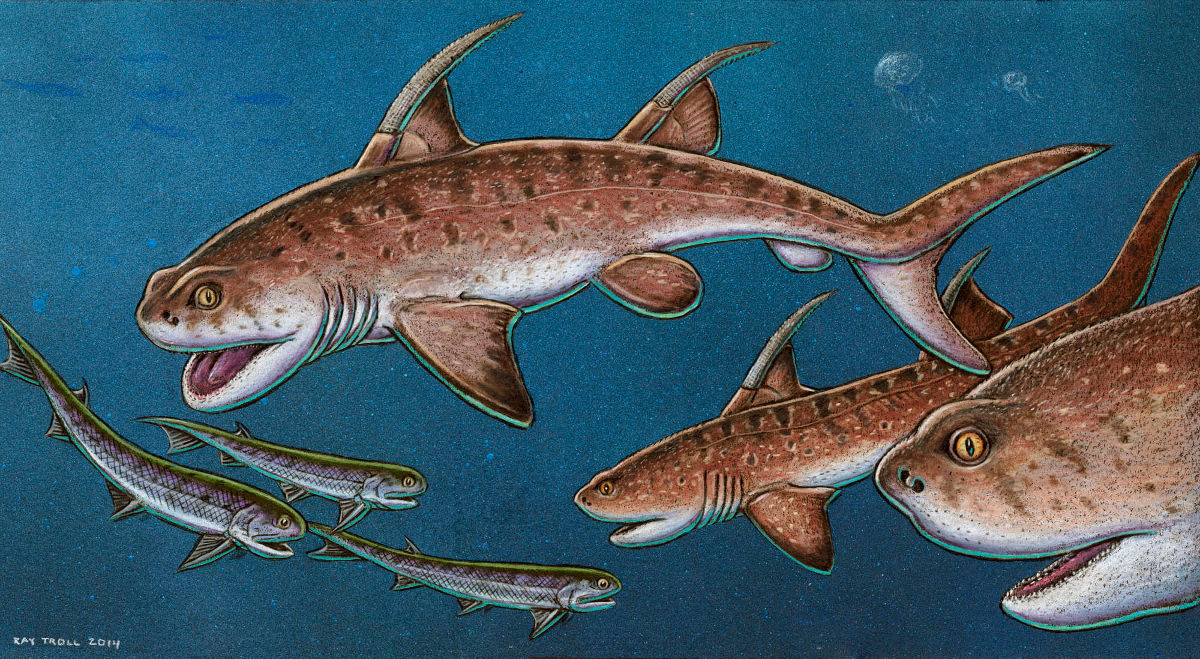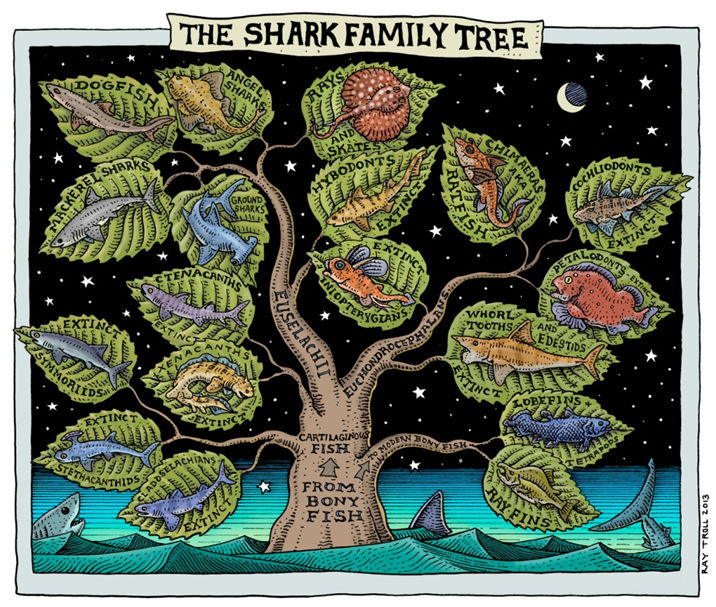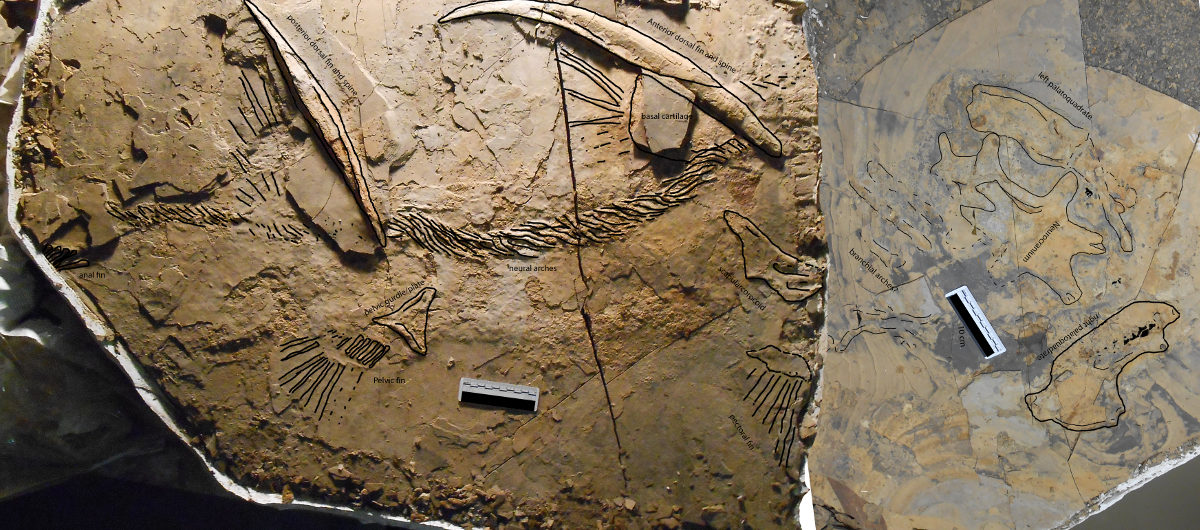The Manzano Ctenacanth: Godzilla Shark of New Mexico!
The Story
About 300 million years ago, in the Manzano Mountains east of Albuquerque, a shallow warm lagoonal estuary was home to a wide variety of plants and animals. Environmental conditions of the bottom of this lagoonal estuary suggest oxygen was extremely poor or not present. This prevented bacterial decomposition of organisms that died and sank to the fine- grained silts and muds to be preserved in relative completeness and in high detail. These conditions preserved thin plant cells, bone, cartilage, and soft tissues.
Paleontologists and geologists from the Smithsonian, Carnegie Museum, University of Kansas and the New Mexico Museum of Natural History and Science have researched the exquisitely preserved fossils from the Manzano Mountains since the late 1960’s. Fossils of plants, invertebrates, small fish, and small amphibians have been collected over the years.
In 2013, during a paleontological conference day trip to the Manzano Mountains, shark paleontologist John-Paul Hodnett serendipitously came across the tip of the nose of a nine foot long ctenacanth (TEEN-uh-kanth) shark (Figure 1). Ctenacanth sharks have large spines in front of their dorsal fins and first appeared in the fossil record during the Late Devonian, about 380 million years ago, and survived until the Early Cretaceous, about 135 million years ago. Scientists in the past proposed that ctenacanths were direct ancestors of modern sharks. Current research, however, suggests ctenacanths might be more closely related to the extinct basal sharks rather than to their modern kin. Until this recent discovery in New Mexico, ctenacanth sharks were known only from two partial skeletons, a few partial skulls, and isolated teeth and dorsal spines. For a shark paleontologist the 2013 discovery was a dream come true…
The shark was exposed on its right side in a fine grained limestone. Due to its size the shark was removed in three sections to be preserved and re-assembled in the paleontology laboratory at the New Mexico Museum of Natural History and Science. The top of the braincase and the right and left upper jaws of the skull, the dorsal fin spines, the vertebral column, and the pectoral and pelvic fins were exposed with mechanical preparation by museum staff. The tail is still being prepared. It is currently under study by Hodnett, Dr. Spencer G. Lucas, and scientists from the American Museum of Natural History in New York and Northern Arizona University in Flagstaff.

What We Are Doing
- Using Computed Tomography (CT), we are scanning the head section of the “Manzano Ctenacanth”
- Scanning the head section we are looking at the composition of the braincase, the palatoquadrate (a single cartilage structure that is the cheek and upper jaw), and looking for the cartilages that make up the Meckel’s cartilages (the lower jaws) and the gill arches, which are not initially seen on the surface of the rock containing the specimen.
- We are CT scanning the full body skeleton of Cobelodus, a smaller shark and a relative of the “Manzano Ctenacanth” found in the Manzano Mountains (Figure 1)
- For Cobelodus, we are looking for hidden structures that are hard to see or that are hidden by sediments to determine the morphology of the skull, visceral skeleton, the body column, and the fins
What We Know
- The “Manzano Ctenacanth” is presently the largest and most complete ctenacanth in the world
- It is presently the largest vertebrate fossil to be discovered at the fossil site in the Manzano Mountains
- It is approximately 85 to 90+% complete
- The lack of “claspers”, a skeletal sexual organ on the pelvic fins of male sharks, makes the “Manzano Ctenacanth” a female
- The size of the dorsal fin spines (which are almost two feet long) and the shape of the teeth suggest the “Manzano Ctenacanth” is a new species
- The body of the “Manzano Ctenacanth” was covered with small tooth-like scales, called dermal denticles
- Cobelodus is the most common shark from the fossil site in the Manzano Mountains
- Most of the specimens of Cobelodus are small, smaller than “adult specimens” from a similar aged locality in Indiana. These specimens have been proposed to be juveniles in the past.
Why CT Scanning Is Important
- Knowing the structure of the braincase and the visceral skeleton (jaws and gill arches) in the “Manzano Ctenacanth” and Cobelodus will help determine the relationship between these sharks to other extinct and modern cartilaginous fishes (Figure 2)
- The completeness of the “Manzano Ctenacanth” will allow us to use it as a keystone specimen to determine the missing data of other ctenacanth shark specimens around the world
- The “Manzano Ctenacanth”skull can be recreated in three dimensions from the CT data
- A three dimensional skull model can be used to determine how the jaws and gills operated and can help determine how strong of a bite force the “Manzano Ctenacanth” could produce
- A 3D skull of the “Manzano Ctenacanth” could be “printed” for study and display
- CT scanning the Cobelodus will allow us to test the hypothesis that the New Mexico sample represents juveniles in a marine nursery, or are small adults of a new species of Cobelodus, or a completely new shark
- The full skeleton of Cobelodus can be reconstructed three dimensionally from the CT data
- A skeletal model can be made to determine how the shark moved and hunted
- A 3D skeleton of Cobelodus could be “printed” for study and display
Figure 1: bottom left, outline drawing of the “Manzano Ctenacanth”NMMNH P-68537 exposed to the surface; top left, reconstruction of the “Manzano Ctenacanth”; bottom right, outline drawing of NMMNH P-19182, a Cobelodus shark, from New Mexico Quarry; top right, reconstruction of Cobelodus . Both illustrations drawn to scale to a 5’10” male human (©New Mexico Museum of Natural History and Science/JP Hodnett)

Figure 2: “Shark Family Tree” by Ray Troll showing the branch where ctenacanth sharks are related to other cartilaginous fishes and “Bony” fishes (© Ray Troll, reproduced with permission, http://www.trollart.com/)
© Spencer G. Lucas, Ph.D., New Mexico Museum of Natural History and Science, 1801 Mountain Road N. W., Albuquerque, New Mexico 87104-1375 USA


















